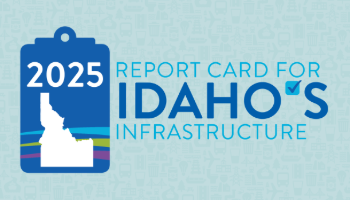Idaho’s infrastructure is improving, demonstrating that proactive state programs and contributions from the federal government and private sector can improve the systems all residents and businesses depend on. Today ASCE’s Idaho sections released its 2025 Report Card for Idaho’s Infrastructure, awarding the state an overall grade of ‘C’, up from a ‘C-’ in 2018. While there is still significant room for improvement, this marks a positive step forward for the state’s infrastructure systems.
The report card was officially unveiled today at the Idaho State Capitol in Boise by the report’s authors and with remarks from State Sen. Lori Den Hartog, R-Meridian, underscoring the importance of infrastructure to the state’s future and the role of public policy in shaping it.
Investments Paying Off
The improved grade reflects the impact of recent infrastructure investments at both the state and federal levels. Idaho has received $3.5 billion through the Infrastructure Investment and Jobs Act (IIJA), which has funded 873 projects—primarily in transportation. These investments are helping Idaho address the needs of one of the nation’s fastest growing populations and the increasing strain from drought and extreme weather events.
At the state level, programs like the Transportation Expansion and Congestion Mitigation (TECM) program raised over $2 billion for roads and bridges since 2019, using asset management to invest in the most cost-effective and necessary maintenance projects. Significant needs still remain across all categories, but Idaho legislators have effectively prioritized projects that have significant impacts on the economy and public safety and made the best use of available resources.
A Closer Look at the Grades
ASCE evaluated nine infrastructure categories essential to Idaho’s economy, public safety, and quality of life. Here’s how the state performed:
| Grade | Categories |
| C+ | Drinking Water, Energy, Wastewater |
| C | Dams, Roads |
| C- | Bridges, Transit |
| D+ | Aviation, Schools |
Roads and Bridges
Roads improved to a ‘C’, with 87% of state highways now in good or fair condition—exceeding the Idaho Transportation Department’s goal. Bridges improved from a ‘D’ to a ‘C-’, with only 5.4% in poor condition, better than the national average. However, 63% of bridges are in fair condition, an indication that many more could drop into ‘poor’ condition if they are not continuously invested in and maintained. The state faces a $2.2 billion funding backlog for bridge maintenance alone.
Energy and Water Infrastructure
Energy, schools, and wastewater saw slight declines. Idaho’s energy infrastructure, while still outperforming the national average, is under pressure from rising demand and aging transmission systems. The state currently consumes four times more energy than it produces.
Drinking water infrastructure received a grade increase to ‘C+’, reflecting efforts to expand treatment and distribution systems, along with the state’s low frequency of Clean Water Act violations. However, aging infrastructure and changing climate patterns—such as reduced snowpack and earlier runoff—are stressing water availability during peak demand periods.
Recommendations to Raise the Grades
- Establish dedicated, long-term funding for critical infrastructure sectors.
- Expand asset management and preventive maintenance to reduce emergency repair costs.
- Prioritize resilience and hazard mitigation in infrastructure planning and design.
- Strengthen partnerships and regional coordination across all levels of government.
- Foster innovation and public engagement to support adoption of new technologies and build public support.
Idaho’s improved grade is a sign of progress, but continued investment, planning, and collaboration will be essential to ensure the state’s infrastructure can support future growth and withstand emerging challenges.
